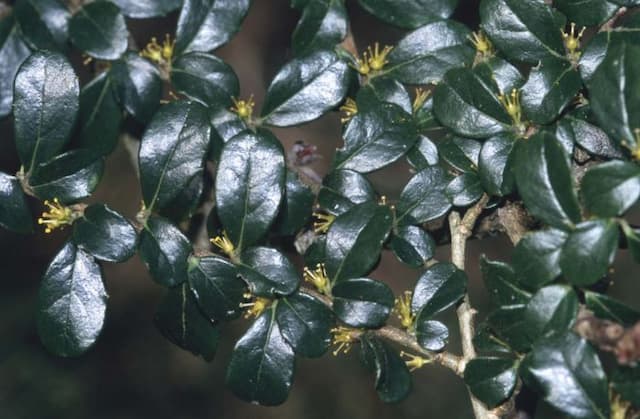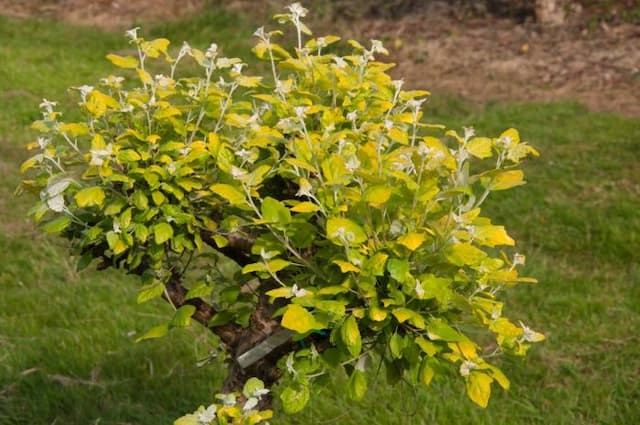Kinuyanagi Willow Salix kinuyanagi (m)

ABOUT
Salix kinuyanagi, commonly known as Kinuyanagi willow, is a species that has a visually appealing presence. The physical characteristics of this plant include long, slender branches that often have a slight droop, adding to its graceful appearance. The bark of this willow is typically a brownish color, which may become more textured and fissured with age. The leaves of the Kinuyanagi willow are one of its most distinctive features. They are generally elongated with a narrow shape and have a finely serrated edge that feels somewhat smooth to the touch. The foliage color is usually a vibrant green, which can turn yellowish during the fall, providing a seasonal display of color. In spring, the Kinuyanagi willow produces flowers known as catkins, which are cylindrical and composed of numerous small flowers. These catkins are often a soft silver or yellow color and add a decorative element to the plant. After flowering, small fruit capsules may be produced, which contain tiny seeds that are dispersed by the wind. The overall form of the plant is shaped by its branching pattern and growth habit, which creates a natural and often picturesque silhouette. The Kinuyanagi willow's appearance can provide a soothing and attractive addition to various landscapes, lending a sense of tranquility and a touch of wild beauty.
About this plant
 Names
NamesFamily
Salicaceae
Synonyms
Kinuyanagi
Common names
Salix kinuyanagi.
 Toxicity
ToxicityTo humans
Salix kinuyanagi, more commonly known as Japanese willow, is not typically known for being poisonous to humans. Members of the Salix family, which includes willows, are widely regarded as non-toxic. While the ingestion of Salix kinuyanagi by humans is generally not associated with severe toxicity, it's always advisable to exercise caution and avoid eating parts of ornamental plants since they are not intended for human consumption. Moreover, individuals who are sensitive to salicylates, compounds related to aspirin that are found in willows, may experience mild reactions if they consume parts of the plant.
To pets
Salix kinuyanagi, known commonly as Japanese willow, is not known to be toxic to pets. Plants in the Salix genus, including willows, are generally considered safe for animals such as dogs and cats. There is no well-documented evidence to suggest that ingestion of the Japanese willow by pets leads to poisoning. However, as with any plant, consumption in large amounts could potentially cause an upset stomach or other non-specific digestive issues in pets, particularly in those with sensitive systems or those who are not accustomed to eating plant material.
 Characteristics
CharacteristicsLife cycle
Perennials
Foliage type
Deciduous
Color of leaves
Green
Height
6-10 feet (1.8-3 meters)
Spread
4-8 feet (1.2-2.4 meters)
Plant type
Tree
Hardiness zones
5
Native area
Asia
Benefits
 General Benefits
General Benefits- Erosion Control: Salix kinuyanagi, commonly known as Japanese willow, has a robust root system that helps stabilize soil and prevent erosion, particularly along streambanks and waterways.
- Habitat Creation: The Japanese willow provides a suitable habitat for local wildlife, such as birds and beneficial insects, offering both shelter and food sources like insects and caterpillars.
- Soil Improvement: As a pioneering species, it can improve soil quality through the accumulation of organic matter as its leaves fall and decompose.
- Windbreak: With its dense foliage and fast-growing branches, it can act as a windbreak, protecting smaller plants and reducing wind erosion.
- Noise Reduction: The thick growth of Japanese willow can help to dampen noise pollution when planted in groups, making it useful for urban areas.
- Aesthetic Appeal: With its long, slender leaves and graceful form, the Japanese willow is often used in ornamental landscaping for visual interest throughout the seasons.
- Streambank Stabilization: Because of its preference for moist environments, it is particularly effective for stabilizing banks of streams, lakes, and other water bodies.
- Shade Provider: As a medium to large-sized tree, it offers ample shade, creating cooler microclimates which can be beneficial during hot weather.
- Support for Livestock: In rural areas, it can provide shade and shelter for livestock and might also serve as a source of fodder in some circumstances.
- Biomass Production: Salix kinuyanagi has potential for biomass production, which can be used for energy or as raw material in various industries.
 Medical Properties
Medical Properties- Anti-inflammatory: Salix kinuyanagi may contain salicylates, which are compounds that can help reduce inflammation.
- Analgesic: The salicylates in Salix kinuyanagi might also act as a pain reliever.
- Antipyretic: Extracts from Salix kinuyanagi could be used to reduce fever due to the presence of salicylate-like compounds.
- Antirheumatic: Traditionally, some Salix species have been used to treat rheumatic conditions, Salix kinuyanagi might share this property.
 Air-purifying Qualities
Air-purifying QualitiesThis plant is not specifically known for air purifying qualities.
 Other Uses
Other Uses- Traditional crafts: The flexible branches of willow (Salix kinuyanagi) can be woven into baskets, furniture, and other artisanal items due to their pliability when soaked.
- Erosion control: Willow roots help stabilize soil, making them useful for controlling erosion on riverbanks and slopes.
- Livestock fodder: In some regions, the leaves of willow can be used to feed livestock, providing a source of forage during times when other feeds might be scarce.
- Environmental monitoring: Willows can be used in phytoremediation to clean up contaminated soils, water, or air because they accumulate heavy metals and other pollutants effectively in their tissues.
- Windbreaks: Due to their dense growth habit, willow trees can be planted to act as windbreaks, protecting crops and soil from wind erosion.
- Soil improvement: Willow trees can improve soil quality as their leaf litter decomposes, adding nutrients and organic matter back into the soil.
- Ornamental usage: Some willow species are planted for their decorative catkins and aesthetic appeal in landscapes and gardens.
- Barriers: The dense nature of willow hedges can act as natural barriers to define boundaries or to screen off areas for privacy.
- Moisture indicators: The presence of willow trees can indicate high soil moisture levels, as they typically grow near water sources.
- Horticultural grafting: Willow branches contain hormones that can promote root growth, so they can be used in grafting to help other plants establish roots more effectively.
Interesting Facts
 Feng Shui
Feng ShuiThe plant Salix kinuyanagi, commonly known as Giant Pussy Willow, is not used in Feng Shui practice.
 Zodiac Sign Compitability
Zodiac Sign CompitabilityThe Giant Pussy Willow is not used in astrology practice.
 Plant Symbolism
Plant Symbolism- Resilience: The willow is known for its flexible branches, so it symbolizes the ability to adapt and bend without breaking, suggesting resilience in the face of adversity.
- Growth: As willows grow quickly and strongly, they are often associated with new growth, development, and personal progress.
- Healing: Traditionally, willow bark has been used for medicinal purposes, which makes the plant a symbol of healing and recovery.
- Femininity: The graceful nature of the willow's branches and its association with water often link it to feminine qualities, such as intuition, emotion, and the mysteries of the subconscious.
- Flexibility: Given its ability to bend in incredible ways without snapping, the willow represents flexibility not just physically but also in thinking and in life situations.
- Grief: In some cultures, the willow is considered a tree of mourning, thus symbolizing the serenity and grace in sorrow or the acceptance of loss.
- Protection: Certain folklore traditions hold that willows offer protection from evil or harm due to their perceived magical properties.
- Inspiration: It's said that the gentle rustling of willow leaves in the breeze can inspire artistic and creative endeavors, symbolizing inspiration and muse-like qualities.
 Water
WaterThe Japanese Fantail willow (Salix sachalinensis 'Sekka'), which is comparable to Salix kinuyanagi, requires consistently moist soil and should not be allowed to dry out between waterings. In general, this plant benefits from deep watering at least once a week, with the amount adjusted according to weather conditions. During hot and dry periods, watering frequency should increase to every 2-3 days. Each watering session should provide the plant with approximately 1-2 gallons of water, allowing moisture to penetrate deeply into the root zone. Young trees may need more frequent watering, about 2-4 gallons per week, to establish a healthy root system.
 Light
LightThe Japanese Fantail willow thrives in full sun to partial shade. It should be planted in a spot where it can receive at least six hours of direct sunlight daily for optimal growth. Areas with morning sun and afternoon shade are ideal to prevent leaf scorch during the hottest part of the day in areas with intense summer heat.
 Temperature
TemperatureThe Japanese Fantail willow is hardy and can withstand a wide range of temperatures. It is capable of surviving in temperatures as low as -20 degrees Fahrenheit and as high as 120 degrees Fahrenheit. However, the ideal temperature range for this willow is between 40 and 75 degrees Fahrenheit. Exposure to extreme temperatures for prolonged periods should be avoided to prevent stress and damage to the plant.
 Pruning
PruningPruning the Japanese Fantail willow is important to maintain its unique shape and to encourage healthy growth. It is best pruned in late winter or early spring before the new growth starts. Remove any dead, damaged, or diseased branches, and thin out crowded areas to increase light penetration and air circulation. Pruning can be done annually, focusing on shaping the tree and managing its size.
 Cleaning
CleaningAs needed
 Soil
SoilThe best soil mix for the Japanese Willow should be moist, well-draining, and fertile with a pH of around 5.5 to 7. To achieve this, blend garden soil, peat, and perlite or sand in equal parts. Regularly add organic matter to maintain fertility and structure.
 Repotting
RepottingJapanese Willows, being larger shrubs, do not require frequent repotting. They should be planted in the ground where possible. If potted, repotting every 2 to 3 years or when noticeably root-bound is appropriate.
 Humidity & Misting
Humidity & MistingJapanese Willows thrive best in moderate to high humidity levels. They are adaptable but prefer consistently moist environments, without the need for tropical humidity conditions.
 Suitable locations
Suitable locationsIndoor
Ensure bright light, keep soil moist.
Outdoor
Full sun to partial shade, moist soil.
Hardiness zone
5-8 USDA
 Life cycle
Life cycleSalix kinuyanagi, commonly known as Kinuyanagi Willow, typically starts its life cycle with the germination of seeds that fall onto moist soil in spring, facilitated by the plant's preference for wet environments such as riverbanks. After germination, the seedling grows rapidly, developing roots and shoots that quickly establish the plant. As the Kinuyanagi Willow matures, it develops a strong, woody stem and a dense canopy of long, narrow leaves, usually reaching maturity within a few years. This dioecious species then produces catkins, with the male plants displaying yellowish catkins and the females with greenish ones, which are wind-pollinated. After pollination, female trees develop small capsules containing numerous tiny seeds that are dispersed by wind or water. The willow's life cycle can continue for several decades, with some trees having the ability to spread vegetatively through root suckers or stem cuttings that take root readily, creating new plants.
 Propogation
PropogationPropogation time
Spring to early summer
Salix kinuyanagi, commonly known as Kīnuyanagi willow, can be effectively propagated through hardwood cuttings, a method popular for many willow species. This process typically takes place during the plant's dormancy period in late winter to early spring before the willow has begun to leaf out. To propagate, one selects a healthy, mature branch and cuts a section approximately 9 to 12 inches (about 23 to 30 centimeters) long, making sure that the cutting has several buds. The bottom end of the cutting is then placed directly into moist soil or into a container with water to encourage root growth. Roots are generally expected to form within a few weeks, after which the new willow can be transplanted into its permanent location.









